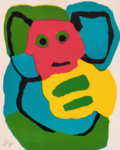
Menagerie: Animals in Art: a new exhibition at the Wellin Museum | by The Spectator | Sep, 2024
It is always amazing to witness how the Wellin Museum transforms its space, making it unique from one exhibit to another. This year, the Wellin presents Menagerie, curated by Elizabeth Shannon, which showcases many different types of art from various cultures, time periods and artists that all feature or incorporate depictions of animals. These works vary from pottery and statues to paintings, in addition to cartoons, drawings and photographs. The exhibit even includes items that were not originally designed to be art, such as kites, beads, coins, dishes and even clothing.
As stated in the synopsis for this exhibition, “Menagerie explores how humans have utilized animal iconography across all areas of cultural production and encourages a thoughtful and conscious understanding of the presence of animals in our everyday lives.” While the natural world is sometimes overlooked in society, it is still always a part of it, and this sentiment is clearly felt in Menagerie’s presentation. Animals are set into art as the main subjects or as background images, with both the intent to encourage appreciation for nature and to comment on it. The items in the exhibition are grouped together thoughtfully, whether they are based on an era, interwoven theme or specific geography. For example, one of the groupings matches depictions of mythical or semi-divine creatures, including a bronze statue of the Roman god Jupiter in the form of a bull, a serpentine beast, the Naga, as seen in Hinduism and an Ancient Roman design of a griffin on a fragment of a sarcophagus.
The pieces of this exhibit also represent how pervasive animal iconography has been in both art and everyday life all throughout history. Some items, like jugs or oil lamps from Ancient Greece or kites designed from Japanese culture, were common objects that everyone had access to, while others, like fine dishes and bowls, were clearly reserved to promote an air of exclusivity. The variety of mediums used for each depiction also reflects this sentiment. Some pieces of art were sketches on standard paper or collages of everyday objects, while others used finer materials to construct bronze statues or amazing pottery.
Because animal iconography often has a greater metaphorical or symbolic meaning, many of the pieces shown were more nuanced than they might have initially presented. Animal imagery can be used to represent violence or peace, reality or the imaginary, nature or humanity — or even a combination of multiple ideas. On the coins from Ancient Greece and Rome, animals were used to represent certain gods, as well as places, political figures or leaders. Figurines or beads were used as protection charms or carried religious meaning. Certain animals could also be interpreted as omens or signs of status. There is a duality to animal depictions that has been utilized in many different ways to best describe specific messages, feelings and symbols.
Another important feature that Menagerie draws attention to is the potentially violent context behind some animal depictions. Animal welfare was not always at the forefront of every artist’s mind and portrayals of circuses, fighting rings or zoos expose some of the ways that animals have been exploited or mistreated in society.
Animal symbolism has been used throughout history both to send messages about the natural world and to represent features of humanity. For example, the political cartoonist, Thomas Nast, used animal images in a satirical fashion to represent countries, political parties and significant people to expose the corruption and other distasteful features of these subjects. One of the powerful characteristics of animal symbolism is that most everyone can understand the message, regardless of their status or level of education. In the opposite sense, animals were also depicted with human characteristics or personified into everyday life, once again showing the similarities between people and nature.
The Wellin Museum is open and free to everyone from Tuesday to Saturday, 11 a.m. to 5 p.m., and Menagerie exhibit will be featured from Sep. 7, 2024 to June 8, 2025. Keep an eye out for special tours and events throughout the year based on the new exhibition.



